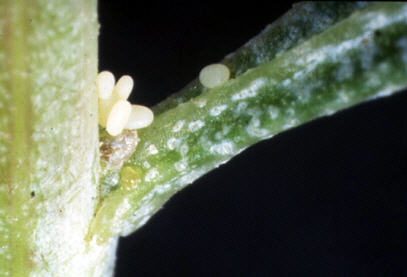Eggs can be laid on plant surfaces, into plant tissues and into crevices in plant surfaces. They can be deposited individually, in small groups or in large masses. It is possible to exploit an
insect's specific oviposition requirements to concentrate oviposition and enhance collection of eggs or young larvae. For example, the
Baccharis halimifolia cerambycid Megacyllene mellyi lays eggs individually in fissures in the bark of its host
(McFadyen 1983). In insectary rearing of
M. mellyi, additional crevices were produced on host stem-cuttings by wrapping cloth tape spirally around the cuttings
(Tomley 1990). This concentrated the eggs and subsequent young larvae and reduced the quantity of stem material needed and the amount of handling required prior to transfer of larvae to artificial diet. The
Acacia nilotica chrysomelid Weiseana barkeri oviposits egg masses in fissures in the bark of its host. Marohasy
(1994) found that adult females of
W. barkeri oviposit into strips of corrugated cardboard attached to host foliage and used this method to obtain concentrated supplies of eggs for mass rearing.

Eggs oviposited in a leaf axil (Photo courtesy of Queensland
Government, Department of
Natural Resources and Mines).
[ Back ] [ Next ]
Graham Donnelly

